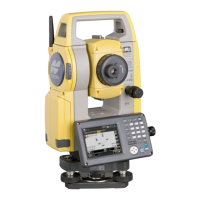
Do you have a question about the Topcon OS-101 and is the answer not in the manual?
| Brand | Topcon |
|---|---|
| Model | OS-101 |
| Category | Measuring Instruments |
| Language | English |
Explains the meaning of various symbols used throughout the manual for better understanding.
Offers key notes on manual conventions, including model specifics and general usage guidance.
Defines and explains various symbols (Warning, Caution, Prohibited, Must Perform) for user safety.
Provides essential safety precautions regarding instrument usage, environment, and handling.
Safety guidelines for handling batteries, chargers, and power cables to prevent hazards.
Safety instructions for tripod use and Bluetooth functionality, including low-temperature precautions.
Guidelines for safe battery charging, warranty, and handling, including temperature limits.
Advice on handling the instrument, protecting it from water/dust, and managing clamps and batteries.
Operational advice for cold conditions, including frost removal and battery performance.
Details laser classifications and critical warnings for safe laser operation and exposure prevention.
Cautions for laser operation, including avoiding direct viewing, reflective surfaces, and proper handling.
Detailed labeling and description of all external parts and their functions on the instrument.
Explains guide light, sighting collimator, trigger key, laser-pointer, and Bluetooth antenna functions.
Overview of operating modes and technical details/precautions for Bluetooth wireless technology.
Details essential key functions like power, backlight, mode switching, and basic operations.
Guides on inputting characters, numbers, selecting options, and navigating menus.
Explains display operation, touch panel usage, status bar indicators, and Starkey mode access.
Step-by-step guide for safely inserting and removing USB memory devices into the instrument's ports.
Comprehensive instructions for charging the battery, including procedures, temperature ranges, and indicators.
Steps for correctly installing and removing the battery from the instrument, with safety notes.
Procedures for accurately centering the instrument over the survey point using optical or laser plumming.
Detailed steps for leveling the instrument using foot screws and checking with levels.
Covers powering the instrument on/off, resume function, and battery status checks.
Procedures for touch panel configuration and resolving software issues via warm/cold boot.
Steps to set up Bluetooth communication, including Master/Slave modes and device registration.
Instructions for connecting USB devices, transferring data, and establishing RS232C serial communication.
Procedures for aiming the telescope and eliminating parallax for precise sighting.
Steps to measure angles and set horizontal angles to zero or specific values.
Explains angle measurement and outputting results to external devices in GTS or SET format.
Procedure to check signal return and perform distance measurements, including distance/angle combined.
Explains the REM function for measuring heights of inaccessible targets.
Procedure for inputting instrument station data, height, and setting the azimuth angle.
Details on measuring targets to find their 3D coordinates using station and backsight data.
Procedures for determining instrument station position and height by measuring known points.
Overview of the calculation process and precautions for optimal point arrangement.
Explains how the guide light assists in target positioning for setting-out operations.
Procedures for setting out points based on distance, angle, or pre-defined coordinates.
Finding a target point by measuring to an offset point at a known distance and angle.
Finding a target point by measuring angles to offset points on its sides.
Finding a target point by measuring distances to two offset points.
Procedure for measuring slope distance, horizontal distance, and angle to multiple targets without instrument movement.
How to change the current starting point to the last measured point for continuous MLM.
Steps for calculating surface area by measuring points and using slope area calculations.
Configuration for observation conditions, distance display, tilt compensation, and instrument settings.
Settings for EDM ALC, laser pointer, key backlight, prism constants, and atmospheric correction.
Guide on allocating tabs, customizing screen controls, softkeys, and Starkey mode icons.
Configuration for measurement units, password protection, date/time, and restoring default settings.
Lists common error messages related to battery, conditions, calculations, and input.
Details errors for Bluetooth, signal loss, target finding, temperature, tilt, and timeouts.
Procedures for checking and adjusting the circular level and tilt sensor for accurate readings.
Checks for collimation error, reticle alignment, and optical/laser plummet adjustments.
Procedures for checking and adjusting additive distance constant and laser plummet functionality.
Describes plumb bob, tubular compass, and telescope eyepiece lens for enhanced functionality.
Information on diagonal eyepiece, solar filter, interface cables, and 2-point target for specific tasks.
Details specifications for the telescope and angle measurement system, including accuracy and compensation.
Lists distance measurement ranges, accuracy, and atmospheric correction input parameters.
Overview of general specs like memory, Bluetooth, power supply, battery, and charger details.
Steps to manually index the vertical circle for high-precision angle measurements, ensuring accuracy.
Explains distance calculation formulas that account for atmospheric refraction and earth curvature.
Information on FCC compliance, RF exposure guidelines, and manufacturer declaration.
Compliance details for battery materials, recycling, EMC, and WEEE directive for EU states.